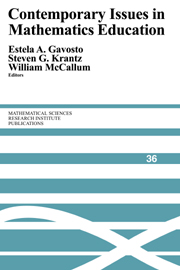Book contents
The Use of Technology in the Teaching of Mathematic
Published online by Cambridge University Press: 27 June 2025
Summary
Members: Peter Alfeld, Kirby Baker, Angela Cheer, Estela Gavosto (Discussion Leader), Ben Halperin (Reporter), Tom Judson, Abel Klein, Gerardo Lafferriere, Charles Lamb, John Orr, Bob Weiland
Questions for Day 1
• Give a specific example of how you have used technology in your teaching (Which courses, how much use, who used it, what was it used for: motivation, illustration, heuristic arguments, numerical computations, symbolic computations, graphical work, more advanced problems).
• How successful was it? How did it help or hinder student learning, compared to teaching the same topic without technology?
Questions for Day 2
• In general, what are the problems to think about when considering the use of technology? (Effect on later courses where technology is used, training for the workplace, …) Distinguish between problems that are inherent in the technology and those coming from the implementation.
• What do you think the future role of technology in teaching mathematics should be?
Introduction. The discussions in our group were very lively during the two days that the group met. The dominating concern was that technology is already a part of everyday life. In the near future, whether we like it or not, it will be an essential part in the teaching of mathematics. The choice for research mathematicians is what role we will play in this change. In our group, we covered a broad range of issues. Not surprisingly, the computational capabilities of the technology were not discussed much. Main issues were the potential of the technology as a communication tool and the demand for it in the workplace. Recommendations.
Information
- Type
- Chapter
- Information
- Contemporary Issues in Mathematics Education , pp. 145 - 146Publisher: Cambridge University PressPrint publication year: 1999
